Higher National Diploma: Pitching and Negotiation Skills Assignment
VerifiedAdded on 2021/07/05
|57
|15232
|85
Report
AI Summary
This assignment report, prepared for a Higher National Diploma in Business Management, focuses on Unit 44: Pitching and Negotiation Skills. It encompasses two main sections: Section 01 involves creating a guidance document for small businesses on effective negotiation, covering topics such as the negotiation process, key steps, generating business deals, tendering for contracts, and the contractual process. Section 02 requires the student to deliver a presentation, including a 2-3 minute pitch and a 10-minute negotiation, simulating a scenario where a small pastry shop pitches for a cafeteria contract. The assignment also involves producing a report evaluating the pitch and negotiation process, analyzing the stages from initial preparation to contract finalization. The report explores key concepts such as the Request for Proposal (RFP) process, competitive tendering, and strategies to achieve a sustainable competitive edge. The student is expected to demonstrate an understanding of negotiation techniques, documentation management, and post-pitch obligations.
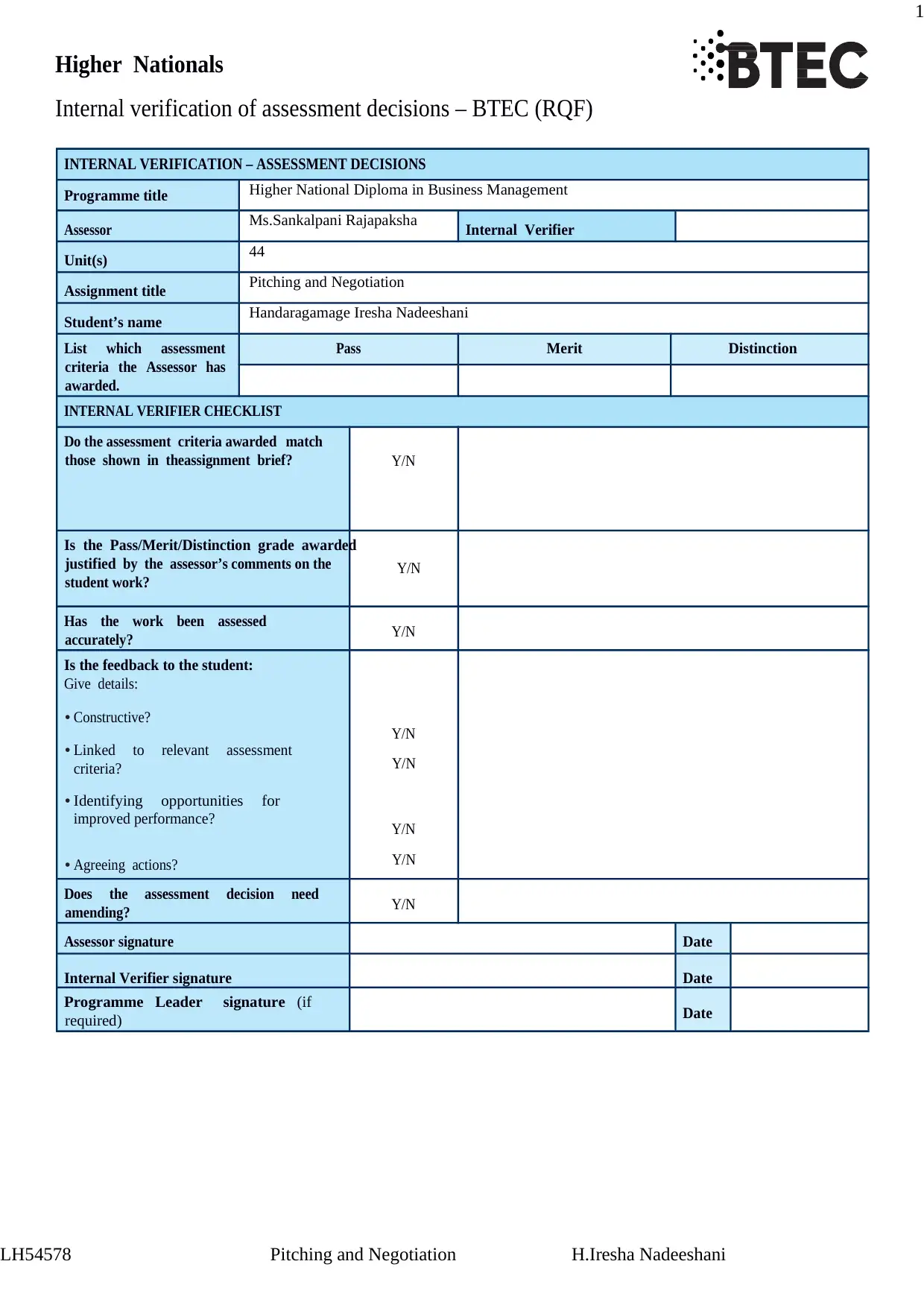
1
Higher Nationals
Internal verification of assessment decisions – BTEC (RQF)
INTERNAL VERIFICATION – ASSESSMENT DECISIONS
Programme title Higher National Diploma in Business Management
Assessor Ms.Sankalpani Rajapaksha Internal Verifier
Unit(s) 44
Assignment title Pitching and Negotiation
Student’s name Handaragamage Iresha Nadeeshani
List which assessment
criteria the Assessor has
awarded.
Pass Merit Distinction
INTERNAL VERIFIER CHECKLIST
Do the assessment criteria awarded match
those shown in theassignment brief? Y/N
Is the Pass/Merit/Distinction grade awarded
justified by the assessor’s comments on the
student work? Y/N
Has the work been assessed
accurately? Y/N
Is the feedback to the student:
Give details:
• Constructive?
• Linked to relevant assessment
criteria?
• Identifying opportunities for
improved performance?
• Agreeing actions?
Y/N
Y/N
Y/N
Y/N
Does the assessment decision need
amending? Y/N
Assessor signature Date
Internal Verifier signature Date
Programme Leader signature (if
required) Date
LH54578 Pitching and Negotiation H.Iresha Nadeeshani
Higher Nationals
Internal verification of assessment decisions – BTEC (RQF)
INTERNAL VERIFICATION – ASSESSMENT DECISIONS
Programme title Higher National Diploma in Business Management
Assessor Ms.Sankalpani Rajapaksha Internal Verifier
Unit(s) 44
Assignment title Pitching and Negotiation
Student’s name Handaragamage Iresha Nadeeshani
List which assessment
criteria the Assessor has
awarded.
Pass Merit Distinction
INTERNAL VERIFIER CHECKLIST
Do the assessment criteria awarded match
those shown in theassignment brief? Y/N
Is the Pass/Merit/Distinction grade awarded
justified by the assessor’s comments on the
student work? Y/N
Has the work been assessed
accurately? Y/N
Is the feedback to the student:
Give details:
• Constructive?
• Linked to relevant assessment
criteria?
• Identifying opportunities for
improved performance?
• Agreeing actions?
Y/N
Y/N
Y/N
Y/N
Does the assessment decision need
amending? Y/N
Assessor signature Date
Internal Verifier signature Date
Programme Leader signature (if
required) Date
LH54578 Pitching and Negotiation H.Iresha Nadeeshani
Paraphrase This Document
Need a fresh take? Get an instant paraphrase of this document with our AI Paraphraser
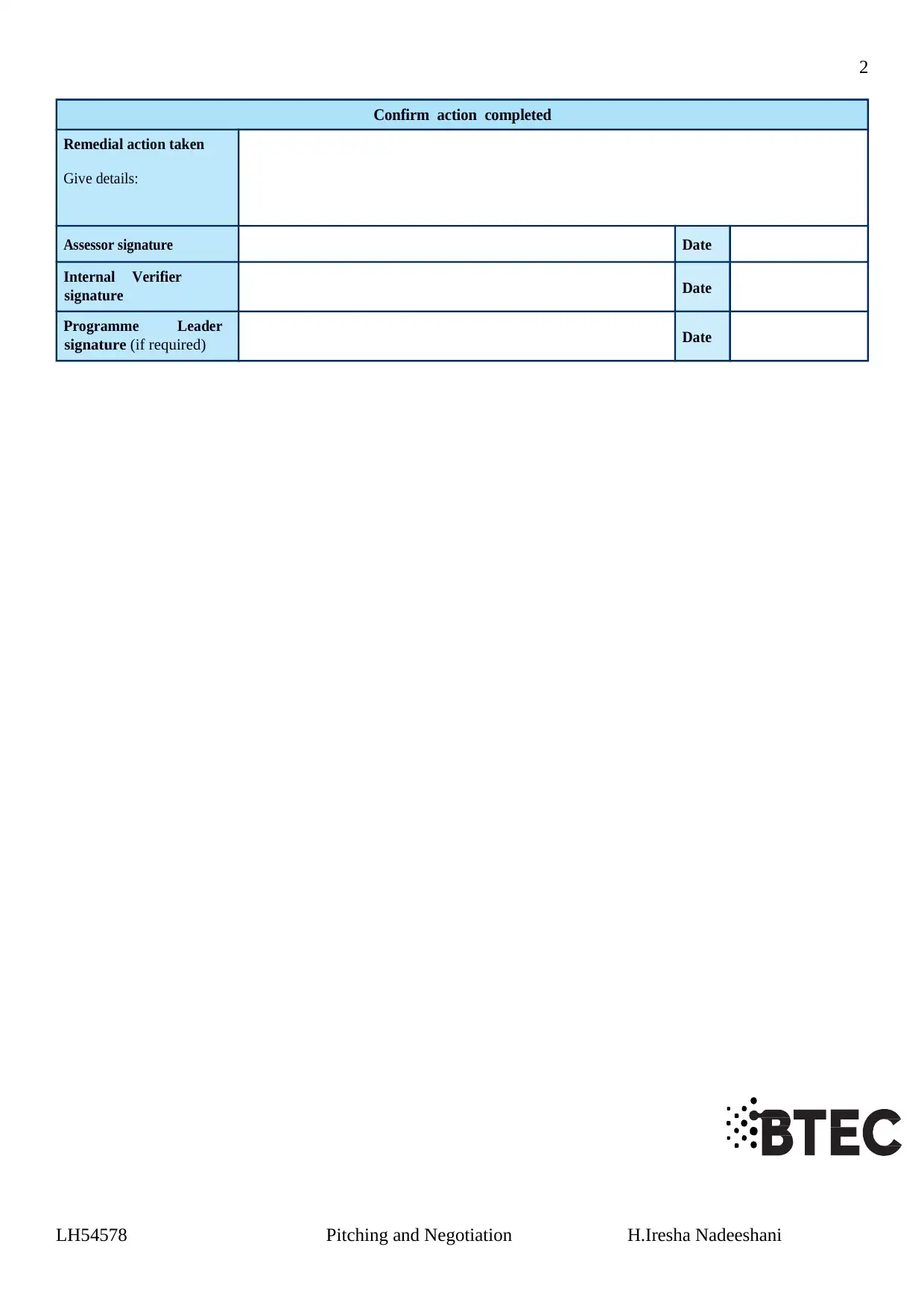
2
Confirm action completed
Remedial action taken
Give details:
Assessor signature Date
Internal Verifier
signature Date
Programme Leader
signature (if required) Date
LH54578 Pitching and Negotiation H.Iresha Nadeeshani
Confirm action completed
Remedial action taken
Give details:
Assessor signature Date
Internal Verifier
signature Date
Programme Leader
signature (if required) Date
LH54578 Pitching and Negotiation H.Iresha Nadeeshani
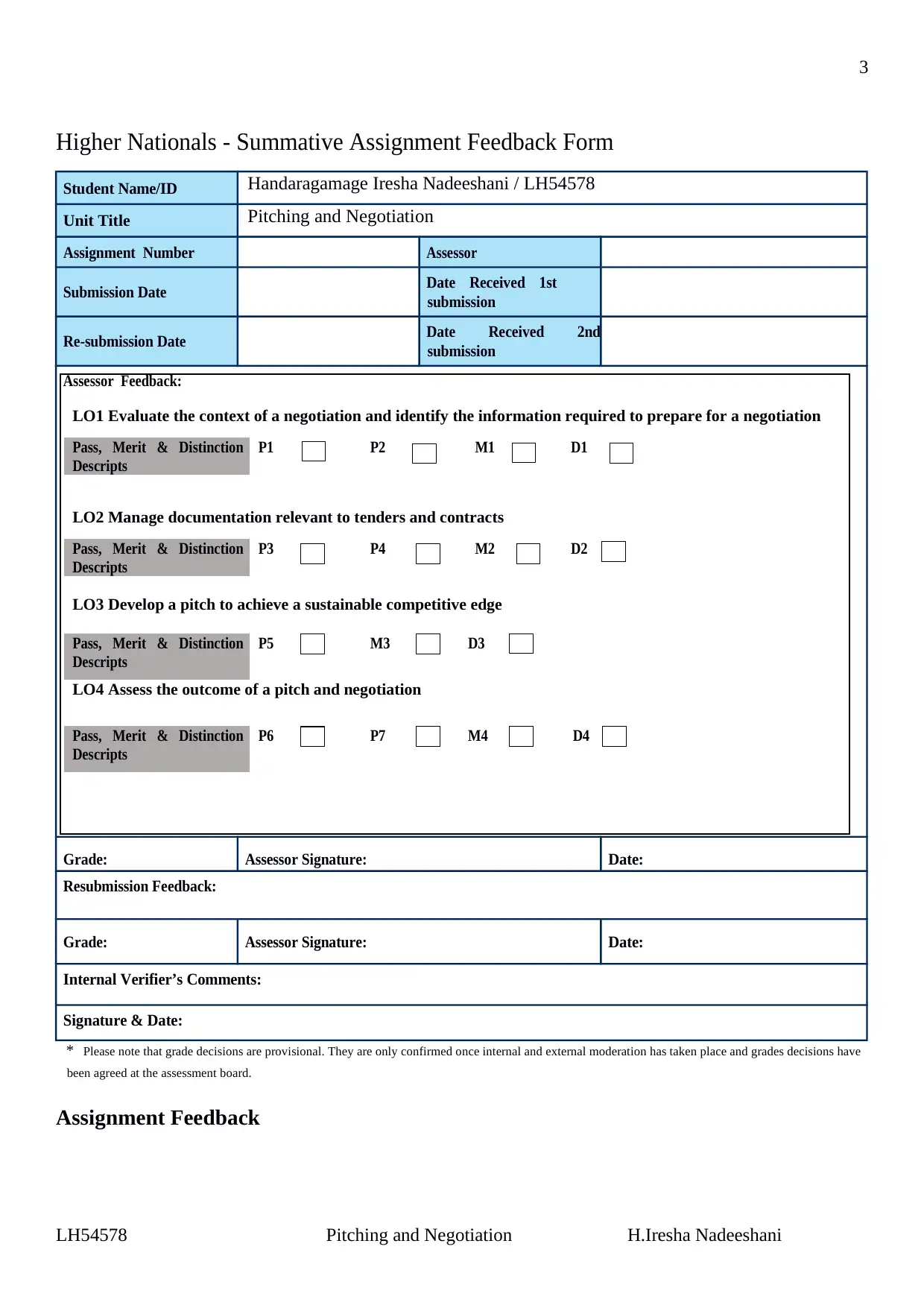
3
Higher Nationals - Summative Assignment Feedback Form
Student Name/ID Handaragamage Iresha Nadeeshani / LH54578
Unit Title Pitching and Negotiation
Assignment Number Assessor
Submission Date Date Received 1st
submission
Re-submission Date Date Received 2nd
submission
Assessor Feedback:
LO1 Evaluate the context of a negotiation and identify the information required to prepare for a negotiation
Pass, Merit & Distinction
Descripts
P1 P2 M1 D1
LO2 Manage documentation relevant to tenders and contracts
Pass, Merit & Distinction
Descripts
P3 P4 M2 D2
LO3 Develop a pitch to achieve a sustainable competitive edge
Pass, Merit & Distinction
Descripts
P5 M3 D3
LO4 Assess the outcome of a pitch and negotiation
Pass, Merit & Distinction
Descripts
P6 P7 M4 D4
Grade: Assessor Signature: Date:
Resubmission Feedback:
Grade: Assessor Signature: Date:
Internal Verifier’s Comments:
Signature & Date:
* Please note that grade decisions are provisional. They are only confirmed once internal and external moderation has taken place and grades decisions have
been agreed at the assessment board.
Assignment Feedback
LH54578 Pitching and Negotiation H.Iresha Nadeeshani
Higher Nationals - Summative Assignment Feedback Form
Student Name/ID Handaragamage Iresha Nadeeshani / LH54578
Unit Title Pitching and Negotiation
Assignment Number Assessor
Submission Date Date Received 1st
submission
Re-submission Date Date Received 2nd
submission
Assessor Feedback:
LO1 Evaluate the context of a negotiation and identify the information required to prepare for a negotiation
Pass, Merit & Distinction
Descripts
P1 P2 M1 D1
LO2 Manage documentation relevant to tenders and contracts
Pass, Merit & Distinction
Descripts
P3 P4 M2 D2
LO3 Develop a pitch to achieve a sustainable competitive edge
Pass, Merit & Distinction
Descripts
P5 M3 D3
LO4 Assess the outcome of a pitch and negotiation
Pass, Merit & Distinction
Descripts
P6 P7 M4 D4
Grade: Assessor Signature: Date:
Resubmission Feedback:
Grade: Assessor Signature: Date:
Internal Verifier’s Comments:
Signature & Date:
* Please note that grade decisions are provisional. They are only confirmed once internal and external moderation has taken place and grades decisions have
been agreed at the assessment board.
Assignment Feedback
LH54578 Pitching and Negotiation H.Iresha Nadeeshani
⊘ This is a preview!⊘
Do you want full access?
Subscribe today to unlock all pages.

Trusted by 1+ million students worldwide
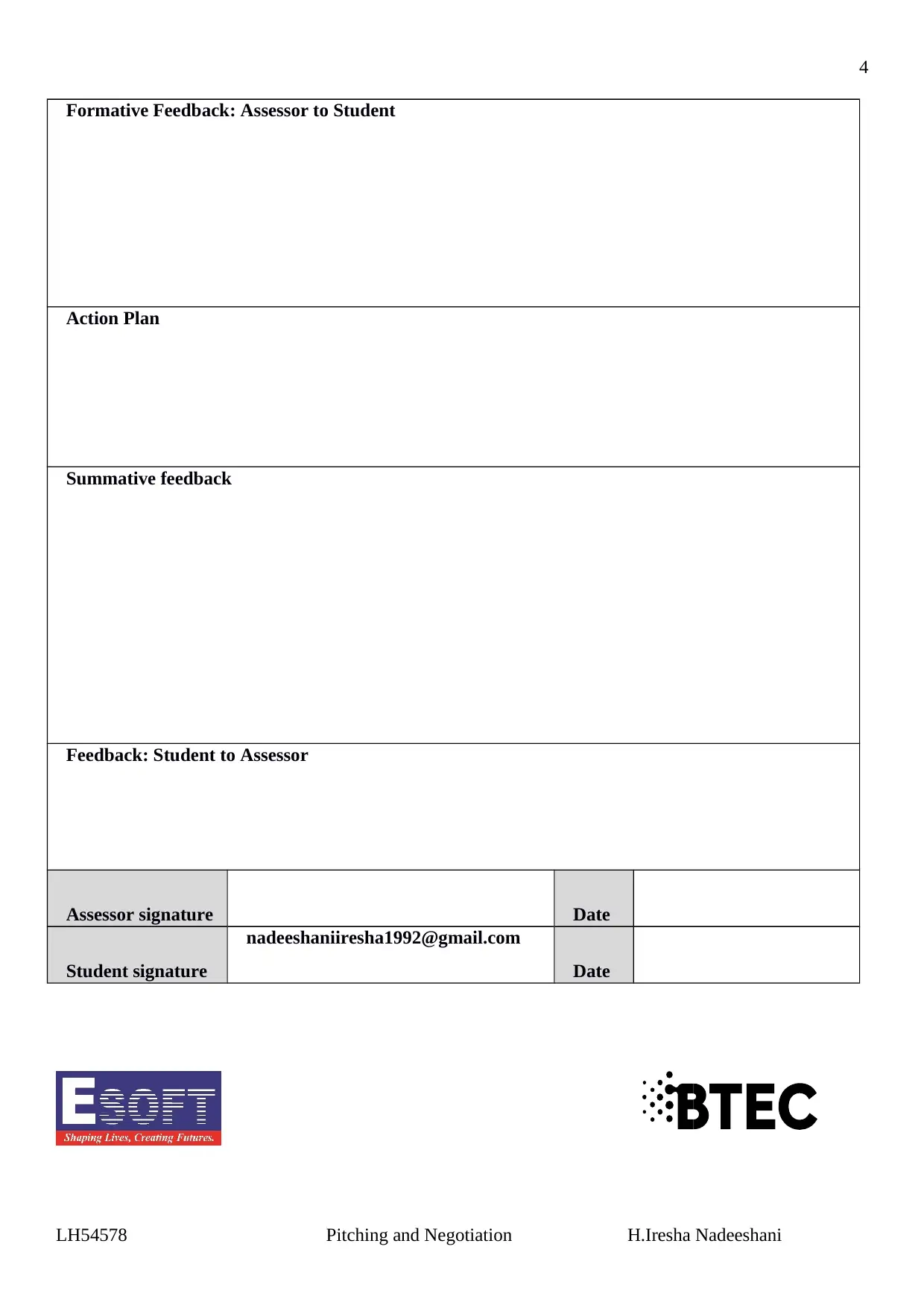
4
Formative Feedback: Assessor to Student
Action Plan
Summative feedback
Feedback: Student to Assessor
Assessor signature Date
Student signature
nadeeshaniiresha1992@gmail.com
Date
LH54578 Pitching and Negotiation H.Iresha Nadeeshani
Formative Feedback: Assessor to Student
Action Plan
Summative feedback
Feedback: Student to Assessor
Assessor signature Date
Student signature
nadeeshaniiresha1992@gmail.com
Date
LH54578 Pitching and Negotiation H.Iresha Nadeeshani
Paraphrase This Document
Need a fresh take? Get an instant paraphrase of this document with our AI Paraphraser
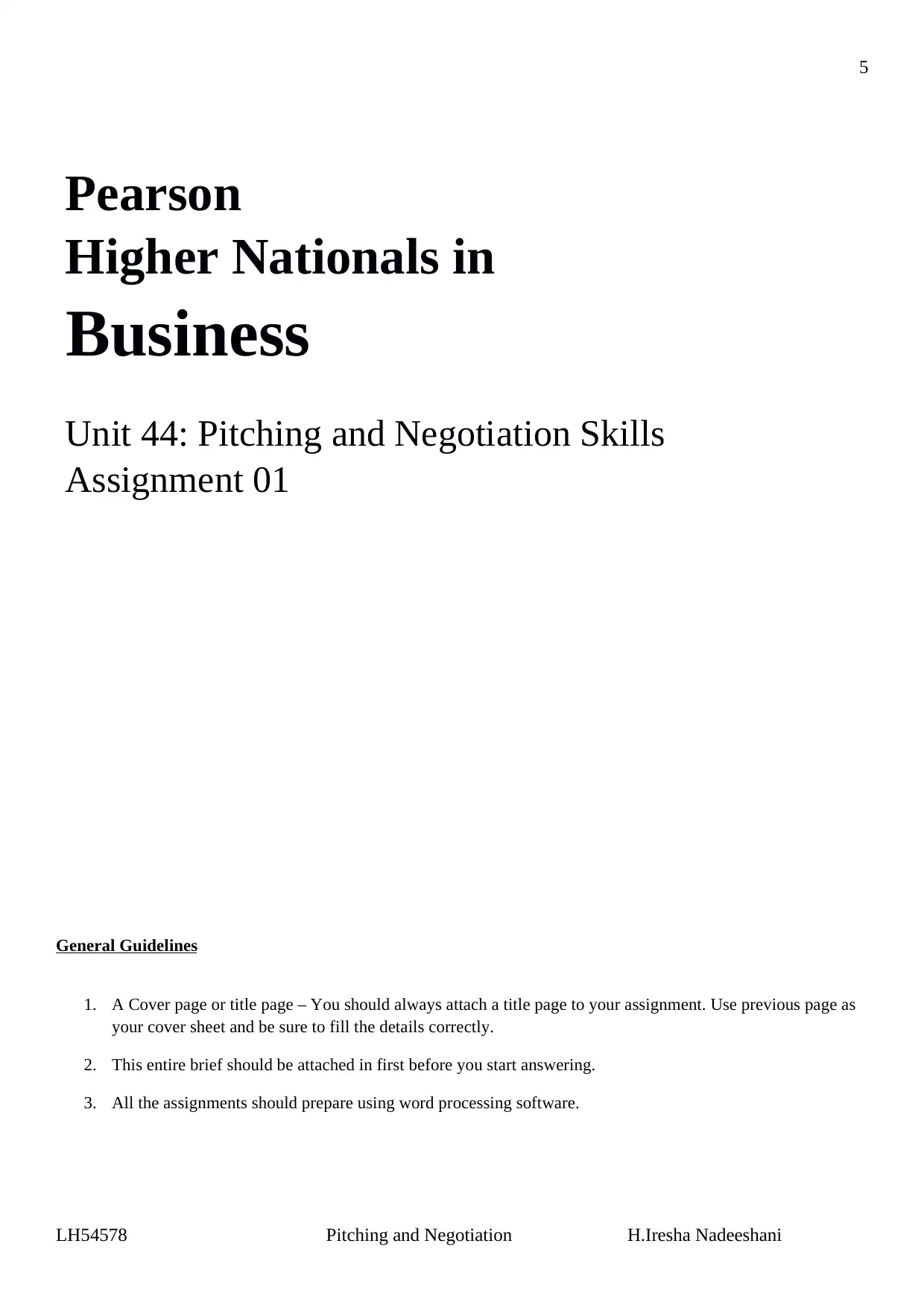
5
Pearson
Higher Nationals in
Business
Unit 44: Pitching and Negotiation Skills
Assignment 01
General Guidelines
1. A Cover page or title page – You should always attach a title page to your assignment. Use previous page as
your cover sheet and be sure to fill the details correctly.
2. This entire brief should be attached in first before you start answering.
3. All the assignments should prepare using word processing software.
LH54578 Pitching and Negotiation H.Iresha Nadeeshani
Pearson
Higher Nationals in
Business
Unit 44: Pitching and Negotiation Skills
Assignment 01
General Guidelines
1. A Cover page or title page – You should always attach a title page to your assignment. Use previous page as
your cover sheet and be sure to fill the details correctly.
2. This entire brief should be attached in first before you start answering.
3. All the assignments should prepare using word processing software.
LH54578 Pitching and Negotiation H.Iresha Nadeeshani
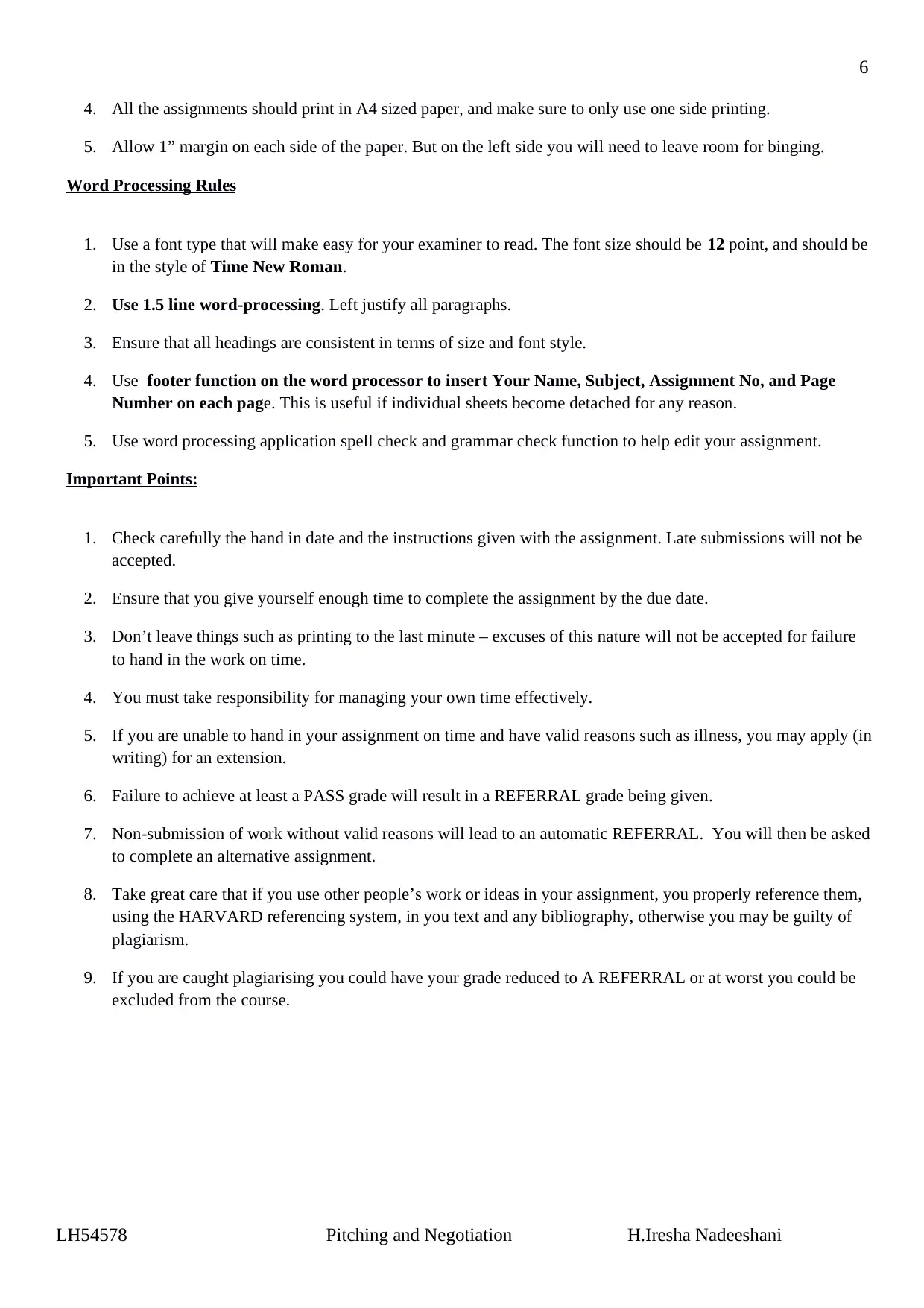
6
4. All the assignments should print in A4 sized paper, and make sure to only use one side printing.
5. Allow 1” margin on each side of the paper. But on the left side you will need to leave room for binging.
Word Processing Rules
1. Use a font type that will make easy for your examiner to read. The font size should be 12 point, and should be
in the style of Time New Roman.
2. Use 1.5 line word-processing. Left justify all paragraphs.
3. Ensure that all headings are consistent in terms of size and font style.
4. Use footer function on the word processor to insert Your Name, Subject, Assignment No, and Page
Number on each page. This is useful if individual sheets become detached for any reason.
5. Use word processing application spell check and grammar check function to help edit your assignment.
Important Points:
1. Check carefully the hand in date and the instructions given with the assignment. Late submissions will not be
accepted.
2. Ensure that you give yourself enough time to complete the assignment by the due date.
3. Don’t leave things such as printing to the last minute – excuses of this nature will not be accepted for failure
to hand in the work on time.
4. You must take responsibility for managing your own time effectively.
5. If you are unable to hand in your assignment on time and have valid reasons such as illness, you may apply (in
writing) for an extension.
6. Failure to achieve at least a PASS grade will result in a REFERRAL grade being given.
7. Non-submission of work without valid reasons will lead to an automatic REFERRAL. You will then be asked
to complete an alternative assignment.
8. Take great care that if you use other people’s work or ideas in your assignment, you properly reference them,
using the HARVARD referencing system, in you text and any bibliography, otherwise you may be guilty of
plagiarism.
9. If you are caught plagiarising you could have your grade reduced to A REFERRAL or at worst you could be
excluded from the course.
LH54578 Pitching and Negotiation H.Iresha Nadeeshani
4. All the assignments should print in A4 sized paper, and make sure to only use one side printing.
5. Allow 1” margin on each side of the paper. But on the left side you will need to leave room for binging.
Word Processing Rules
1. Use a font type that will make easy for your examiner to read. The font size should be 12 point, and should be
in the style of Time New Roman.
2. Use 1.5 line word-processing. Left justify all paragraphs.
3. Ensure that all headings are consistent in terms of size and font style.
4. Use footer function on the word processor to insert Your Name, Subject, Assignment No, and Page
Number on each page. This is useful if individual sheets become detached for any reason.
5. Use word processing application spell check and grammar check function to help edit your assignment.
Important Points:
1. Check carefully the hand in date and the instructions given with the assignment. Late submissions will not be
accepted.
2. Ensure that you give yourself enough time to complete the assignment by the due date.
3. Don’t leave things such as printing to the last minute – excuses of this nature will not be accepted for failure
to hand in the work on time.
4. You must take responsibility for managing your own time effectively.
5. If you are unable to hand in your assignment on time and have valid reasons such as illness, you may apply (in
writing) for an extension.
6. Failure to achieve at least a PASS grade will result in a REFERRAL grade being given.
7. Non-submission of work without valid reasons will lead to an automatic REFERRAL. You will then be asked
to complete an alternative assignment.
8. Take great care that if you use other people’s work or ideas in your assignment, you properly reference them,
using the HARVARD referencing system, in you text and any bibliography, otherwise you may be guilty of
plagiarism.
9. If you are caught plagiarising you could have your grade reduced to A REFERRAL or at worst you could be
excluded from the course.
LH54578 Pitching and Negotiation H.Iresha Nadeeshani
⊘ This is a preview!⊘
Do you want full access?
Subscribe today to unlock all pages.

Trusted by 1+ million students worldwide
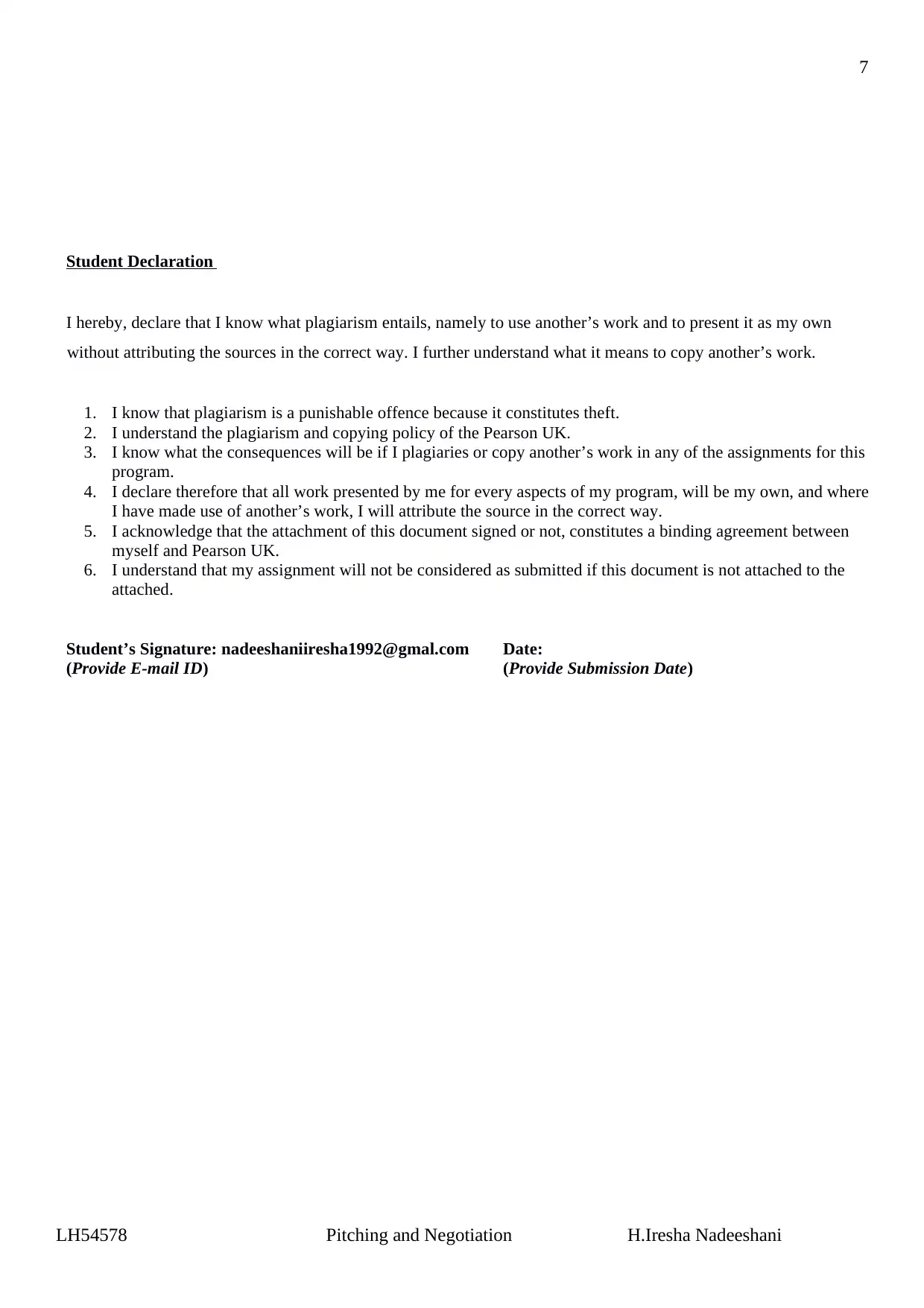
7
Student Declaration
I hereby, declare that I know what plagiarism entails, namely to use another’s work and to present it as my own
without attributing the sources in the correct way. I further understand what it means to copy another’s work.
1. I know that plagiarism is a punishable offence because it constitutes theft.
2. I understand the plagiarism and copying policy of the Pearson UK.
3. I know what the consequences will be if I plagiaries or copy another’s work in any of the assignments for this
program.
4. I declare therefore that all work presented by me for every aspects of my program, will be my own, and where
I have made use of another’s work, I will attribute the source in the correct way.
5. I acknowledge that the attachment of this document signed or not, constitutes a binding agreement between
myself and Pearson UK.
6. I understand that my assignment will not be considered as submitted if this document is not attached to the
attached.
Student’s Signature: nadeeshaniiresha1992@gmal.com Date:
(Provide E-mail ID) (Provide Submission Date)
LH54578 Pitching and Negotiation H.Iresha Nadeeshani
Student Declaration
I hereby, declare that I know what plagiarism entails, namely to use another’s work and to present it as my own
without attributing the sources in the correct way. I further understand what it means to copy another’s work.
1. I know that plagiarism is a punishable offence because it constitutes theft.
2. I understand the plagiarism and copying policy of the Pearson UK.
3. I know what the consequences will be if I plagiaries or copy another’s work in any of the assignments for this
program.
4. I declare therefore that all work presented by me for every aspects of my program, will be my own, and where
I have made use of another’s work, I will attribute the source in the correct way.
5. I acknowledge that the attachment of this document signed or not, constitutes a binding agreement between
myself and Pearson UK.
6. I understand that my assignment will not be considered as submitted if this document is not attached to the
attached.
Student’s Signature: nadeeshaniiresha1992@gmal.com Date:
(Provide E-mail ID) (Provide Submission Date)
LH54578 Pitching and Negotiation H.Iresha Nadeeshani
Paraphrase This Document
Need a fresh take? Get an instant paraphrase of this document with our AI Paraphraser

8
Assignment Brief
Student Name /ID Number Handaragamage Iresha Nadeeshani / LH54578
Unit Number and Title Unit 44 – Pitching and Negotiation Skills
Academic Year
Unit Tutor
Assignment Title Perfect Pitch- Assignment 01
Issue Date
Submission Date
IV Name & Date
Submission Format Section 01 and 02:
Submission format Section 01
The submission is in the form of a PDF guide for small businesses. Templates for guides and brochures
can be accessed on Microsoft File. You are required to make use of headings, paragraphs, subsections and
illustrations as appropriate and all work must be supported with research and referenced using the Harvard
referencing system. Please also provide a bibliography using the Harvard referencing system. The
recommended word limit is 2,000–2,500 words, although you will not be penalised for exceeding the total
word limit.
Submission format for Section 02 has number of components:
• A completed request for proposal. The recommended word limit is 750–1,000 words, although
you will not be penalized for exceeding the total word limit.
• A 2–3-minute pitch, devised and delivered in an appropriate format. This will be recorded for
evidence and submission purposes.
• A 10-minute negotiation. This will be recorded for evidence and submission purposes.
A short report that evaluates the stages of the pitch and negotiation process.
Unit Learning Outcomes:
LO1. Evaluate the context of a negotiation and identify the information required to prepare for a
LH54578 Pitching and Negotiation H.Iresha Nadeeshani
Assignment Brief
Student Name /ID Number Handaragamage Iresha Nadeeshani / LH54578
Unit Number and Title Unit 44 – Pitching and Negotiation Skills
Academic Year
Unit Tutor
Assignment Title Perfect Pitch- Assignment 01
Issue Date
Submission Date
IV Name & Date
Submission Format Section 01 and 02:
Submission format Section 01
The submission is in the form of a PDF guide for small businesses. Templates for guides and brochures
can be accessed on Microsoft File. You are required to make use of headings, paragraphs, subsections and
illustrations as appropriate and all work must be supported with research and referenced using the Harvard
referencing system. Please also provide a bibliography using the Harvard referencing system. The
recommended word limit is 2,000–2,500 words, although you will not be penalised for exceeding the total
word limit.
Submission format for Section 02 has number of components:
• A completed request for proposal. The recommended word limit is 750–1,000 words, although
you will not be penalized for exceeding the total word limit.
• A 2–3-minute pitch, devised and delivered in an appropriate format. This will be recorded for
evidence and submission purposes.
• A 10-minute negotiation. This will be recorded for evidence and submission purposes.
A short report that evaluates the stages of the pitch and negotiation process.
Unit Learning Outcomes:
LO1. Evaluate the context of a negotiation and identify the information required to prepare for a
LH54578 Pitching and Negotiation H.Iresha Nadeeshani
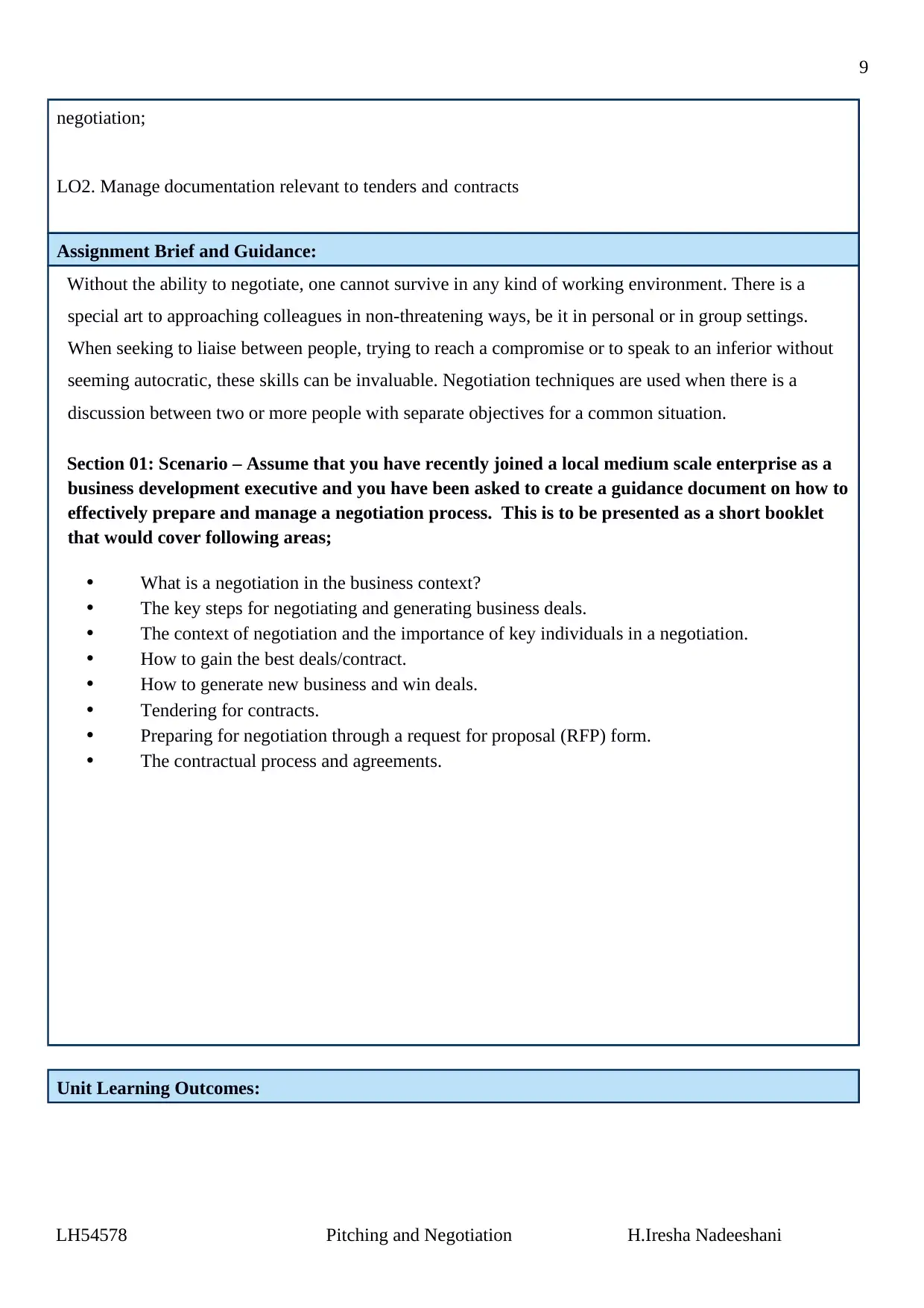
9
negotiation;
LO2. Manage documentation relevant to tenders and contracts
Assignment Brief and Guidance:
Without the ability to negotiate, one cannot survive in any kind of working environment. There is a
special art to approaching colleagues in non-threatening ways, be it in personal or in group settings.
When seeking to liaise between people, trying to reach a compromise or to speak to an inferior without
seeming autocratic, these skills can be invaluable. Negotiation techniques are used when there is a
discussion between two or more people with separate objectives for a common situation.
Section 01: Scenario – Assume that you have recently joined a local medium scale enterprise as a
business development executive and you have been asked to create a guidance document on how to
effectively prepare and manage a negotiation process. This is to be presented as a short booklet
that would cover following areas;
• What is a negotiation in the business context?
• The key steps for negotiating and generating business deals.
• The context of negotiation and the importance of key individuals in a negotiation.
• How to gain the best deals/contract.
• How to generate new business and win deals.
• Tendering for contracts.
• Preparing for negotiation through a request for proposal (RFP) form.
• The contractual process and agreements.
Unit Learning Outcomes:
LH54578 Pitching and Negotiation H.Iresha Nadeeshani
negotiation;
LO2. Manage documentation relevant to tenders and contracts
Assignment Brief and Guidance:
Without the ability to negotiate, one cannot survive in any kind of working environment. There is a
special art to approaching colleagues in non-threatening ways, be it in personal or in group settings.
When seeking to liaise between people, trying to reach a compromise or to speak to an inferior without
seeming autocratic, these skills can be invaluable. Negotiation techniques are used when there is a
discussion between two or more people with separate objectives for a common situation.
Section 01: Scenario – Assume that you have recently joined a local medium scale enterprise as a
business development executive and you have been asked to create a guidance document on how to
effectively prepare and manage a negotiation process. This is to be presented as a short booklet
that would cover following areas;
• What is a negotiation in the business context?
• The key steps for negotiating and generating business deals.
• The context of negotiation and the importance of key individuals in a negotiation.
• How to gain the best deals/contract.
• How to generate new business and win deals.
• Tendering for contracts.
• Preparing for negotiation through a request for proposal (RFP) form.
• The contractual process and agreements.
Unit Learning Outcomes:
LH54578 Pitching and Negotiation H.Iresha Nadeeshani
⊘ This is a preview!⊘
Do you want full access?
Subscribe today to unlock all pages.

Trusted by 1+ million students worldwide
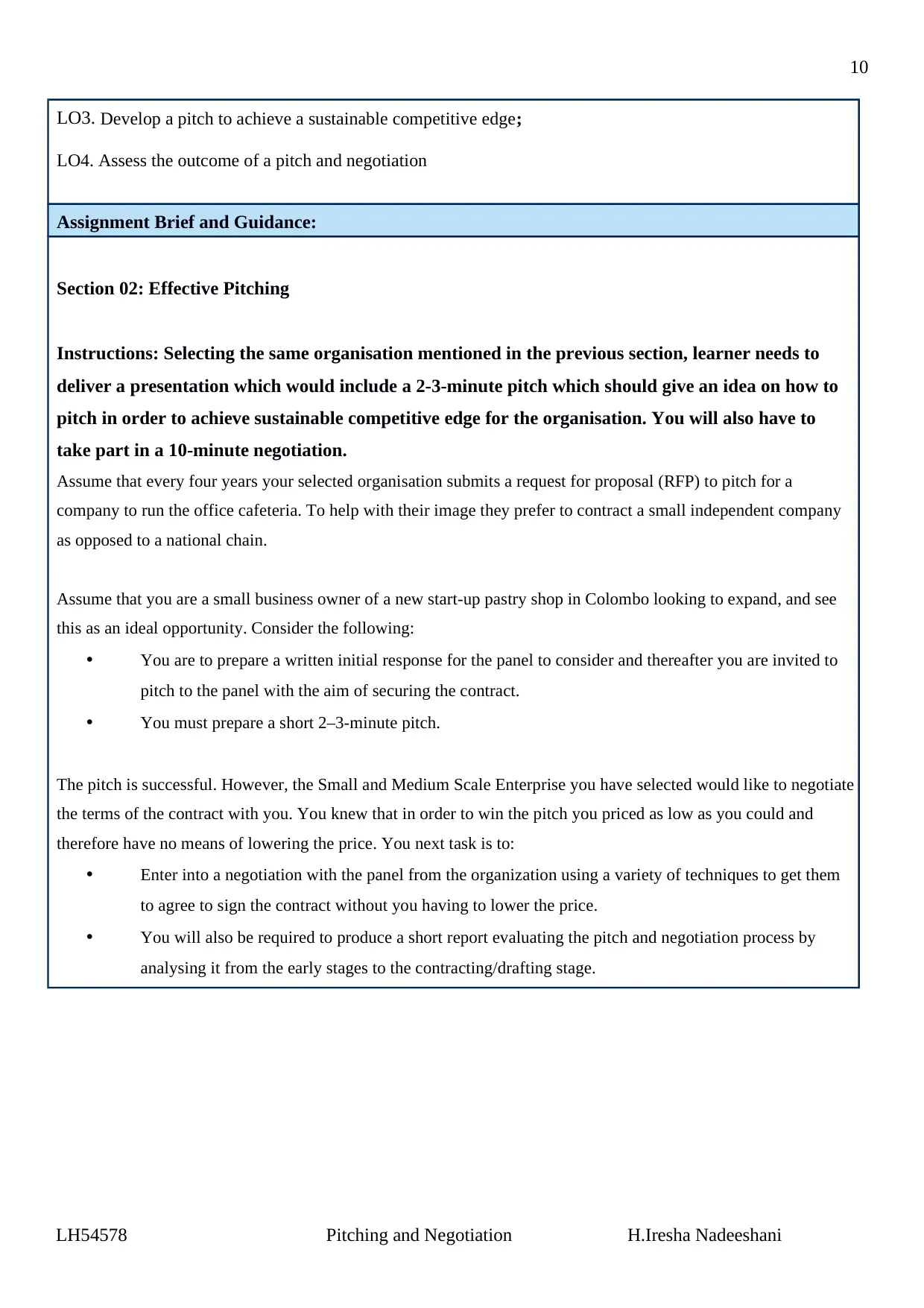
10
LO3. Develop a pitch to achieve a sustainable competitive edge;
LO4. Assess the outcome of a pitch and negotiation
Assignment Brief and Guidance:
Section 02: Effective Pitching
Instructions: Selecting the same organisation mentioned in the previous section, learner needs to
deliver a presentation which would include a 2-3-minute pitch which should give an idea on how to
pitch in order to achieve sustainable competitive edge for the organisation. You will also have to
take part in a 10-minute negotiation.
Assume that every four years your selected organisation submits a request for proposal (RFP) to pitch for a
company to run the office cafeteria. To help with their image they prefer to contract a small independent company
as opposed to a national chain.
Assume that you are a small business owner of a new start-up pastry shop in Colombo looking to expand, and see
this as an ideal opportunity. Consider the following:
• You are to prepare a written initial response for the panel to consider and thereafter you are invited to
pitch to the panel with the aim of securing the contract.
• You must prepare a short 2–3-minute pitch.
The pitch is successful. However, the Small and Medium Scale Enterprise you have selected would like to negotiate
the terms of the contract with you. You knew that in order to win the pitch you priced as low as you could and
therefore have no means of lowering the price. You next task is to:
• Enter into a negotiation with the panel from the organization using a variety of techniques to get them
to agree to sign the contract without you having to lower the price.
• You will also be required to produce a short report evaluating the pitch and negotiation process by
analysing it from the early stages to the contracting/drafting stage.
LH54578 Pitching and Negotiation H.Iresha Nadeeshani
LO3. Develop a pitch to achieve a sustainable competitive edge;
LO4. Assess the outcome of a pitch and negotiation
Assignment Brief and Guidance:
Section 02: Effective Pitching
Instructions: Selecting the same organisation mentioned in the previous section, learner needs to
deliver a presentation which would include a 2-3-minute pitch which should give an idea on how to
pitch in order to achieve sustainable competitive edge for the organisation. You will also have to
take part in a 10-minute negotiation.
Assume that every four years your selected organisation submits a request for proposal (RFP) to pitch for a
company to run the office cafeteria. To help with their image they prefer to contract a small independent company
as opposed to a national chain.
Assume that you are a small business owner of a new start-up pastry shop in Colombo looking to expand, and see
this as an ideal opportunity. Consider the following:
• You are to prepare a written initial response for the panel to consider and thereafter you are invited to
pitch to the panel with the aim of securing the contract.
• You must prepare a short 2–3-minute pitch.
The pitch is successful. However, the Small and Medium Scale Enterprise you have selected would like to negotiate
the terms of the contract with you. You knew that in order to win the pitch you priced as low as you could and
therefore have no means of lowering the price. You next task is to:
• Enter into a negotiation with the panel from the organization using a variety of techniques to get them
to agree to sign the contract without you having to lower the price.
• You will also be required to produce a short report evaluating the pitch and negotiation process by
analysing it from the early stages to the contracting/drafting stage.
LH54578 Pitching and Negotiation H.Iresha Nadeeshani
Paraphrase This Document
Need a fresh take? Get an instant paraphrase of this document with our AI Paraphraser
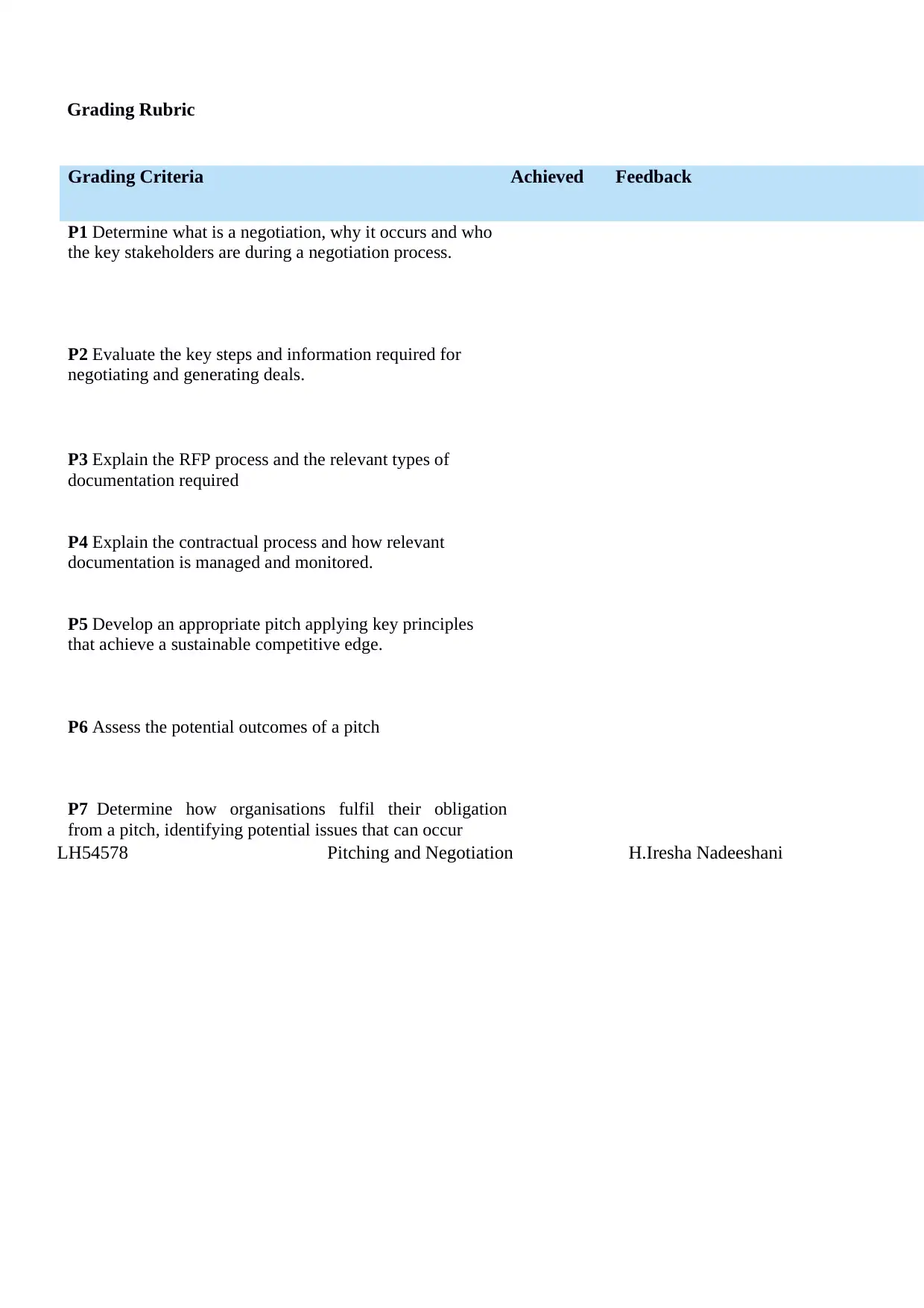
Grading Rubric
Grading Criteria Achieved Feedback
P1 Determine what is a negotiation, why it occurs and who
the key stakeholders are during a negotiation process.
P2 Evaluate the key steps and information required for
negotiating and generating deals.
P3 Explain the RFP process and the relevant types of
documentation required
P4 Explain the contractual process and how relevant
documentation is managed and monitored.
P5 Develop an appropriate pitch applying key principles
that achieve a sustainable competitive edge.
P6 Assess the potential outcomes of a pitch
P7 Determine how organisations fulfil their obligation
from a pitch, identifying potential issues that can occur
LH54578 Pitching and Negotiation H.Iresha Nadeeshani
Grading Criteria Achieved Feedback
P1 Determine what is a negotiation, why it occurs and who
the key stakeholders are during a negotiation process.
P2 Evaluate the key steps and information required for
negotiating and generating deals.
P3 Explain the RFP process and the relevant types of
documentation required
P4 Explain the contractual process and how relevant
documentation is managed and monitored.
P5 Develop an appropriate pitch applying key principles
that achieve a sustainable competitive edge.
P6 Assess the potential outcomes of a pitch
P7 Determine how organisations fulfil their obligation
from a pitch, identifying potential issues that can occur
LH54578 Pitching and Negotiation H.Iresha Nadeeshani
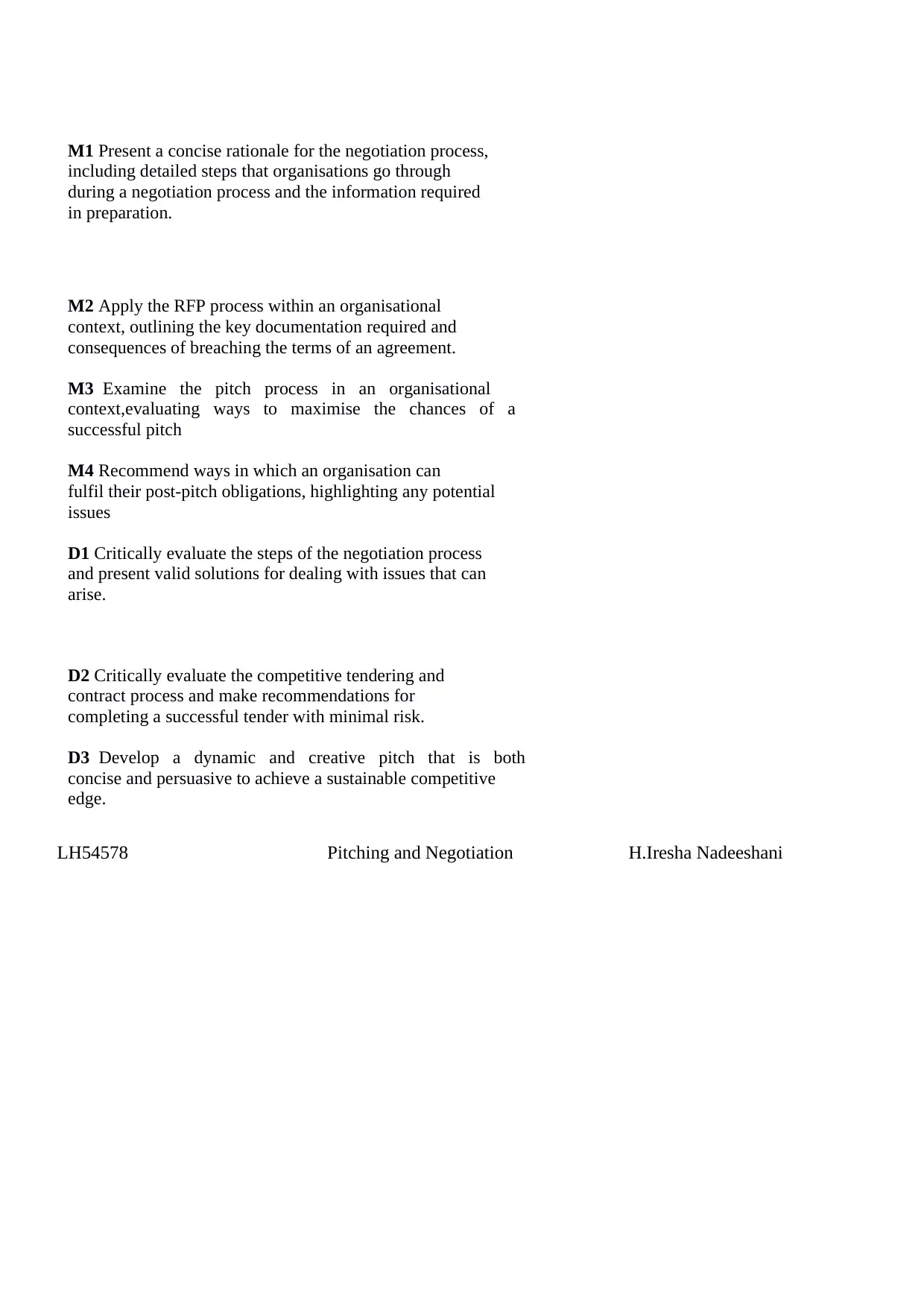
M1 Present a concise rationale for the negotiation process,
including detailed steps that organisations go through
during a negotiation process and the information required
in preparation.
M2 Apply the RFP process within an organisational
context, outlining the key documentation required and
consequences of breaching the terms of an agreement.
M3 Examine the pitch process in an organisational
context,evaluating ways to maximise the chances of a
successful pitch
M4 Recommend ways in which an organisation can
fulfil their post-pitch obligations, highlighting any potential
issues
D1 Critically evaluate the steps of the negotiation process
and present valid solutions for dealing with issues that can
arise.
D2 Critically evaluate the competitive tendering and
contract process and make recommendations for
completing a successful tender with minimal risk.
D3 Develop a dynamic and creative pitch that is both
concise and persuasive to achieve a sustainable competitive
edge.
LH54578 Pitching and Negotiation H.Iresha Nadeeshani
including detailed steps that organisations go through
during a negotiation process and the information required
in preparation.
M2 Apply the RFP process within an organisational
context, outlining the key documentation required and
consequences of breaching the terms of an agreement.
M3 Examine the pitch process in an organisational
context,evaluating ways to maximise the chances of a
successful pitch
M4 Recommend ways in which an organisation can
fulfil their post-pitch obligations, highlighting any potential
issues
D1 Critically evaluate the steps of the negotiation process
and present valid solutions for dealing with issues that can
arise.
D2 Critically evaluate the competitive tendering and
contract process and make recommendations for
completing a successful tender with minimal risk.
D3 Develop a dynamic and creative pitch that is both
concise and persuasive to achieve a sustainable competitive
edge.
LH54578 Pitching and Negotiation H.Iresha Nadeeshani
⊘ This is a preview!⊘
Do you want full access?
Subscribe today to unlock all pages.

Trusted by 1+ million students worldwide
1 out of 57
Related Documents
Your All-in-One AI-Powered Toolkit for Academic Success.
+13062052269
info@desklib.com
Available 24*7 on WhatsApp / Email
![[object Object]](/_next/static/media/star-bottom.7253800d.svg)
Unlock your academic potential
Copyright © 2020–2025 A2Z Services. All Rights Reserved. Developed and managed by ZUCOL.





